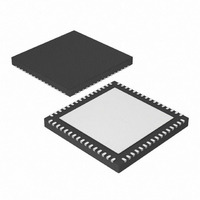PIC24FJ256GB106-I/MR Microchip Technology, PIC24FJ256GB106-I/MR Datasheet - Page 42

PIC24FJ256GB106-I/MR
Manufacturer Part Number
PIC24FJ256GB106-I/MR
Description
IC, 16BIT MCU, PIC24F, 32MHZ, QFN-64
Manufacturer
Microchip Technology
Series
PIC® 24Fr
Datasheets
1.PIC24FJ128GA106-IPT.pdf
(52 pages)
2.PIC24FJ64GB106-IPT.pdf
(16 pages)
3.PIC24FJ64GB106-IPT.pdf
(352 pages)
4.PIC24FJ192GB108-IPT.pdf
(328 pages)
Specifications of PIC24FJ256GB106-I/MR
Controller Family/series
PIC24
No. Of I/o's
51
Ram Memory Size
16KB
Cpu Speed
32MHz
No. Of Timers
5
Core Size
16 Bit
Program Memory Size
256KB
Peripherals
ADC, Comparator, PWM, RTC, Timer
Core Processor
PIC
Speed
32MHz
Connectivity
I²C, SPI, UART/USART, USB OTG
Number Of I /o
51
Program Memory Type
FLASH
Ram Size
16K x 8
Voltage - Supply (vcc/vdd)
2 V ~ 3.6 V
Data Converters
A/D 16x10b
Oscillator Type
Internal
Operating Temperature
-40°C ~ 85°C
Package / Case
64-VFQFN, Exposed Pad
Processor Series
PIC24FJ
Core
PIC
Data Bus Width
16 bit
Data Ram Size
16 KB
Interface Type
I2C, SPI, UART
Maximum Clock Frequency
32 MHz
Number Of Programmable I/os
52
Number Of Timers
5
Maximum Operating Temperature
+ 85 C
Mounting Style
SMD/SMT
3rd Party Development Tools
52713-733, 52714-737, 53276-922, EWDSPIC
Development Tools By Supplier
PG164130, DV164035, DV244005, DV164005, PG164120, DM240001, DM240011
Minimum Operating Temperature
- 40 C
On-chip Adc
10 bit, 16 Channel
Lead Free Status / RoHS Status
Lead free / RoHS Compliant
For Use With
876-1004 - PIC24 BREAKOUT BOARD
Eeprom Size
-
Lead Free Status / Rohs Status
Details
Available stocks
Company
Part Number
Manufacturer
Quantity
Price
Company:
Part Number:
PIC24FJ256GB106-I/MR
Manufacturer:
TI
Quantity:
1 292
- PIC24FJ128GA106-IPT PDF datasheet
- PIC24FJ64GB106-IPT PDF datasheet #2
- PIC24FJ64GB106-IPT PDF datasheet #3
- PIC24FJ192GB108-IPT PDF datasheet #4
- Current page: 42 of 352
- Download datasheet (3Mb)
PIC24FJ256GB110 FAMILY
4.2.2
To maintain backward compatibility with PIC
and improve data space memory usage efficiency, the
PIC24F instruction set supports both word and byte
operations. As a consequence of byte accessibility, all
Effective Address calculations are internally scaled to
step through word-aligned memory. For example, the
core recognizes that Post-Modified Register Indirect
Addressing mode [Ws++] will result in a value of Ws + 1
for byte operations and Ws + 2 for word operations.
Data byte reads will read the complete word which con-
tains the byte, using the LSb of any EA to determine
which byte to select. The selected byte is placed onto
the LSB of the data path. That is, data memory and reg-
isters are organized as two parallel, byte-wide entities
with shared (word) address decode but separate write
lines. Data byte writes only write to the corresponding
side of the array or register which matches the byte
address.
All word accesses must be aligned to an even address.
Misaligned word data fetches are not supported, so
care must be taken when mixing byte and word
operations, or translating from 8-bit MCU code. If a
misaligned read or write is attempted, an address error
trap will be generated. If the error occurred on a read,
the instruction underway is completed; if it occurred on
a write, the instruction will be executed but the write will
not occur. In either case, a trap is then executed, allow-
ing the system and/or user to examine the machine
state prior to execution of the address Fault.
All byte loads into any W register are loaded into the
Least Significant Byte. The Most Significant Byte is not
modified.
TABLE 4-2:
DS39897C-page 42
Legend: — = No implemented SFRs in this block
000h
100h
200h
300h
400h
500h
600h
700h
DATA MEMORY ORGANIZATION
AND ALIGNMENT
I
xx00
PMP
2
A/D
IMPLEMENTED REGIONS OF SFR DATA SPACE
C™
—
—
—
Timers
A/D/CTMU
RTC/Comp
UART
xx20
Core
—
—
—
SPI/UART
System
xx40
CRC
—
—
—
®
devices
SFR Space Address
Capture
NVM/PMD
SPI/I
xx60
ICN
—
—
—
—
2
C
A sign-extend instruction (SE) is provided to allow
users to translate 8-bit signed data to 16-bit signed
values. Alternatively, for 16-bit unsigned data, users
can clear the MSB of any W register by executing a
zero-extend (ZE) instruction on the appropriate
address.
Although most instructions are capable of operating on
word or byte data sizes, it should be noted that some
instructions operate only on words.
4.2.3
The 8-Kbyte area between 0000h and 1FFFh is
referred to as the near data space. Locations in this
space are directly addressable via a 13-bit absolute
address field within all memory direct instructions. The
remainder of the data space is addressable indirectly.
Additionally, the whole data space is addressable using
MOV instructions, which support Memory Direct
Addressing with a 16-bit address field.
4.2.4
The first 2 Kbytes of the near data space, from 0000h
to 07FFh, are primarily occupied with Special Function
Registers (SFRs). These are used by the PIC24F core
and peripheral modules for controlling the operation of
the device.
SFRs are distributed among the modules that they con-
trol and are generally grouped together by module.
Much of the SFR space contains unused addresses;
these are read as ‘0’. A diagram of the SFR space,
showing where SFRs are actually implemented, is
shown in Table 4-2. Each implemented area indicates
a 32-byte region where at least one address is imple-
mented as an SFR. A complete listing of implemented
SFRs, including their addresses, is shown in Tables 4-3
through 4-30.
xx80
SPI
—
—
—
NEAR DATA SPACE
SFR SPACE
Interrupts
UART
xxA0
USB
PPS
—
—
—
2009 Microchip Technology Inc.
Compare
xxC0
—
—
—
I/O
xxE0
—
—
—
—
—
—
Related parts for PIC24FJ256GB106-I/MR
Image
Part Number
Description
Manufacturer
Datasheet
Request
R

Part Number:
Description:
Manufacturer:
Microchip Technology Inc.
Datasheet:

Part Number:
Description:
Manufacturer:
Microchip Technology Inc.
Datasheet:

Part Number:
Description:
Manufacturer:
Microchip Technology Inc.
Datasheet:

Part Number:
Description:
Manufacturer:
Microchip Technology Inc.
Datasheet:

Part Number:
Description:
Manufacturer:
Microchip Technology Inc.
Datasheet:

Part Number:
Description:
Manufacturer:
Microchip Technology Inc.
Datasheet:

Part Number:
Description:
Manufacturer:
Microchip Technology Inc.
Datasheet:

Part Number:
Description:
Manufacturer:
Microchip Technology Inc.
Datasheet:











